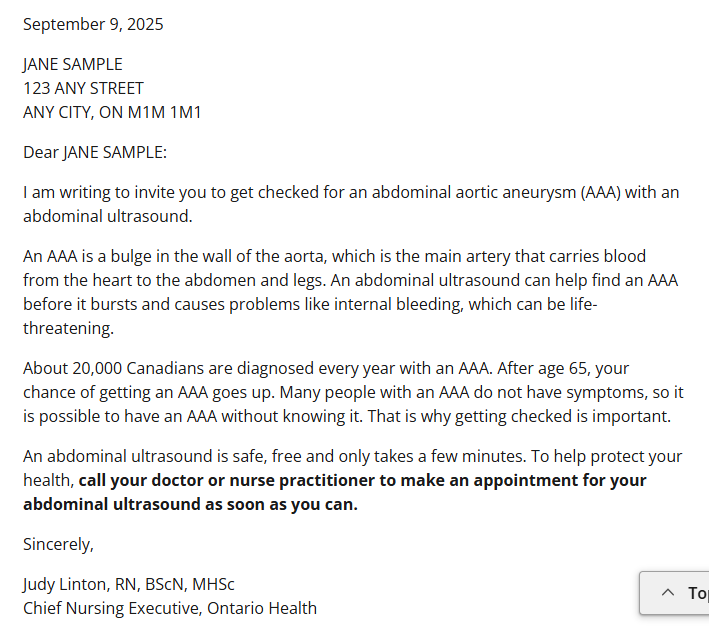Summary
Ontario has launched Canada’s first abdominal aortic aneurysm screening program for adults 65 and older. These aneurysms are often silent until rupture, which can be fatal. A quick, painless ultrasound can detect them early, allowing monitoring or intervention before disaster strikes. Eligible Ontarians will receive an letter inviting them to speak with their doctor to book their free screening. This program is a landmark step in preventive care, aiming to save lives and reduce emergency hospitalizations.
Public-health screening programs are among the quiet triumphs of modern medicine. They rest on a simple but powerful idea: catch problems early often before symptoms appear, and intervene before they become serious.
From mammograms to colon and cervical cancers, widespread screening aims to shift the odds in our favour by detecting disease at a stage when treatment is more effective, less invasive and less costly in human as well as economic terms. Their existence reflects a commitment by a health system to proactive care rather than reactive crisis management, constituting a shift from “treat when it hurts” to “prevent until it doesn’t”.
Ontario introducing abdominal aortic aneurysm screening to people 65+

Now, Ontario is taking an important new step. The province is launching the first-of-its-kind screening initiative in Canada: the Ontario Abdominal Aortic Aneurysm Screening Program (OAAASP), which is inviting adults aged 65 and older to undergo an ultrasound to check for silent abdominal aortic aneurysms (AAA).
An abdominal aortic aneurysm involves a bulging or weakening in the wall of the aorta in the abdomen—often without symptoms until a life-threatening rupture occurs. Studies show that up to 80% of ruptured AAAs lead to death, often before patients even reach the hospital.
With eligible individuals receiving an invitation letter from the Ontario government when they turn 65, the program aims to detect aneurysms early, reduce emergency ruptures and save lives.
By rolling out this screening program, Ontario not only offers older adults another tool for protecting their health—but sets an example for preventive vascular care across Canada.
Why aneurysm screening matters
An abdominal aortic aneurysm (AAA) is often called a “silent killer.” The condition occurs when the wall of the aorta—the body’s largest artery—weakens and begins to bulge outward. Most people have no symptoms until the aneurysm ruptures, which causes internal bleeding that is frequently fatal.
The tragedy is that these aneurysms are detectable long before they become dangerous. A simple, non-invasive ultrasound can identify an AAA in minutes, giving doctors and patients a chance to monitor or treat it before rupture occurs. This is why organized screening programs are so impactful: they don’t just diagnose disease, they prevent catastrophe.
How the screening works
Ontario’s new Abdominal Aortic Aneurysm Screening Program is designed to be simple, accessible, and lifesaving. Starting at age 65, Ontarians will receive a personalized invitation letter from Ontario Health encouraging them to speak with their doctor to book a free ultrasound at a participating diagnostic imaging site.
If you are age 65 or older and have not been offered an abdominal ultrasound, you should ask your primary care provider for one. If you do not have a primary care provider, you can find one through Health Care Connect at 1-800-445-1822 or visit the Health Care Connect website. While searching for your new doctor, you can also visit a nurse practitioner (NP) or a doctor at walk-in clinic in Ontario to order an Abdominal Aortic Aneurysm (AAA) screening.
The test itself is quick and painless. It uses ultrasound imaging to measure the size of the abdominal aorta. If no aneurysm is detected, no further action is required. If one is found, patients are referred for follow-up and ongoing monitoring or, in more severe cases, for consultation with a vascular specialist.
This structured approach ensures that people at highest risk, particularly older adults and long-time smokers, are screened early enough for intervention.
The Importance of preventive health screenings
The launch of this program is more than just a new test—it’s a signal that Ontario’s health system is moving toward increasing proactive care for older adults. Public health experts say that catching conditions like AAA early not only saves lives but also reduces emergency surgeries, hospital stays, and long-term complications.
It’s also a reminder that preventive health screenings are among the simplest, most effective ways you can take control of your health.
As Ontario leads the way with this pioneering initiative, it sets a precedent for the rest of the country: that investing in prevention is one of the smartest ways to protect public health and preserve healthcare resources for the future.
~ Read more from The Health Insider ~
- Is It Dry Skin or Eczema? Here’s How to Tell the Difference and What to Do About ItLearn to tell dry skin from eczema, discover triggers, and explore safe products and treatments for healthier, happier skin.
- Over 65 and Live in Ontario? Don’t Miss the New Free Screening for Abdominal Aortic AneurysmsA simple, painless ultrasound could prevent a life-threatening abdominal aortic rupture. Ontario launches Canada’s first AAA screening program.
- This Simple Wearable Is Helping Seniors Walk With Confidence AgainA Montreal-made wearable helps older adults walk with confidence and reduces their risk of falling.
- How To Transition Your Skincare From Summer To The Harsh Canadian WinterSwitching to winter skincare? Here’s what to keep, what to skip, and how to protect your face and body from dryness.
- Think You Know Diabetes? Half of Canadians Still Believe the MythsFrom “too much sugar” myths to unfair blame, Diabetes Canada is calling on Canadians to stop the stigma and learn the facts.
- Canadian Innovation in Brain Imaging: A Tiny Camera Making Big Strides in NeurosurgeryMeet the Vena MicroAngioscope: a world-first Canadian innovation giving neurosurgeons real-time, full-colour views from inside the brain’s blood vessels.
The information provided on TheHealthInsider.ca is for educational purposes only and does not substitute for professional medical advice. TheHealthInsider.ca advises consulting a medical professional or healthcare provider when seeking medical advice, diagnoses, or treatment.






